Alongside monitoring their website's crawling, indexing and ranking statuses, Google Search Console also has a range of tools to monitor your website's structured data. It will help you see what structured data elements you have on your website, whether there are any warnings with your structured data, and whether there are any errors causing elements not to show.
It calls this toolset "Enhancements". And in this article, we will talk you through what structured data is, what the enhancements tab is and what enhancements it shows.
What is structured data?
Structured data is a common way of marking up your website's content to ensure search engines can understand it better. This is a good thing because when a search engine (such as Google) understands your content better, your content is more likely to show up within rich results.
What is a rich result?
Rich results are enhanced search results that include additional information, rather than just a meta title, slug and meta description. Examples include star ratings, reviews and images.
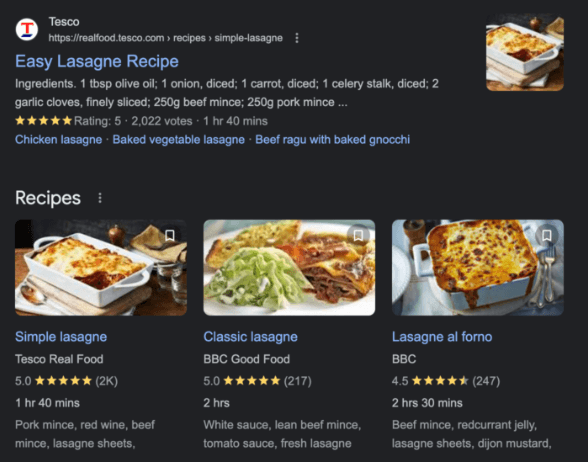
The above is an example of some rich results in Google for the search term "lasagne recipe". We can see that in Tesco's main search listing, we see:
- A star rating.
- The number of people who have voted / reviewed this recipe.
- The time the recipe takes to complete.
- An image taken from the web page.
We can also see some additional rich snippets below using recipes from BBC Good Food and the BBC. Also including star reviews and estimated time to complete.
Marketers love rich results as they help websites stand out within the search engine results pages and, often, increase the number of clicks that website is getting.
What is the 'Enhancements' tab within Google Search Console?
The 'Enhancements' tab within Google Search Console is, simply put, a section that allows you to track the performance of your website's structured data. It will provide you with a few pieces of helpful information including:
- The total number of pages on your website that have structured data.
- The types of structured data that are used on your website.
- The total number of times your website has appeared in a rich result.
The enhancements section within Google Search Console also shows errors and warnings, but we will go into that in more detail later.
When you open up your Google Search Console dashboard, you will see the enhancements section on the left-hand side of your screen. Although please note this only occurs if you are using structured data on your website. If you are not using any structured data, the entire section will be blank.
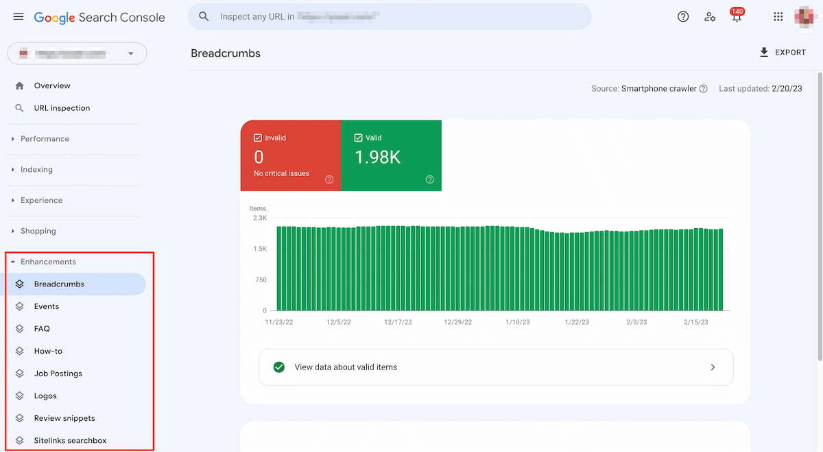
There is a dropdown section where you can click on each enhancement such as breadcrumbs or events. This will allow you to monitor each section individually and track the improvements you have made.
The enhancements tab shows errors and warnings.
As we mentioned above, the enhancements tab will also show warnings and errors, if any, for your structured data.
A warning within your structured data means it is still valid and can, indeed, show up in rich snippets. It simply means there is a chance to further improve your structured data to give it a better chance of showing up within rich snippets. An error, however, means Google cannot fully understand or read your structured data, and it is not currently showing up in any rich snippets.
So whilst warnings can be read, and can sometimes show in rich snippets, they may need a little "extra help" to get there and give it the best chance of resulting in a rich snippet appearance. An error, on the other hand, means there is work to be done before the structured data even has a chance at ranking within a rich snippet.
Below, you will see a short snippet of structured data which includes some warnings:
<script type="application/ld+json">
{
"@context": "http://schema.org",
"@type": "Product",
"name": "iPhone 13 Pro",
"image": "https://www.apple.com/iphone/13-pro/images/hero.jpg",
"description": "The iPhone 13 Pro is the most advanced iPhone yet. It features a triple-lens camera system, a powerful A15 Bionic chip, and a long-lasting battery.",
"price": 999,
"availability": "In stock",
"rating": 4.5
}
</script>
In this example, there are two warnings:
- The availability property is missing the condition attribute.
- The rating property is missing the reviewCount attribute.
Here's the same markup with the warnings corrected:
<script type="application/ld+json">
{
"@context": "http://schema.org",
"@type": "Product",
"name": "iPhone 13 Pro",
"image": "https://www.apple.com/iphone/13-pro/images/hero.jpg",
"description": "The iPhone 13 Pro is the most advanced iPhone yet. It features a triple-lens camera system, a powerful A15 Bionic chip, and a long-lasting battery.",
"price": 999,
"availability": {
"@type": "InStock",
"condition": "New"
},
"rating": {
"@type": "Rating",
"ratingValue": 4.5,
"reviewCount": 1000
}
}
</script>
You can see that the condition attribute and the reviewCount attribute have now been added to the markup. This will correct the warnings and give your page a better chance of showing up as a rich snippet.
Errors are slightly more complex. Here's an example of markup with an error:
<script type="application/ld+json">
{
"@context": "http://schema.org",
"@type": "Product",
"name": "iPhone 13 Pro",
"image": "https://www.apple.com/iphone/13-pro/images/hero.jpg",
"description": "The iPhone 13 Pro is the most advanced iPhone yet. It features a triple-lens camera system, a powerful A15 Bionic chip, and a long-lasting battery.",
"price": 999,
"availability": "In stock",
"rating": "4.5"
}
</script>
In this markup, the rating property is not a valid JSON object.
For you keen-eyed readers, it also includes the warning that the rating property is missing the reviewCount attribute.
Here's the same markup with the errors and warnings corrected:
<script type="application/ld+json">
{
"@context": "http://schema.org",
"@type": "Product",
"name": "iPhone 13 Pro",
"image": "https://www.apple.com/iphone/13-pro/images/hero.jpg",
"description": "The iPhone 13 Pro is the most advanced iPhone yet. It features a triple-lens camera system, a powerful A15 Bionic chip, and a long-lasting battery.",
"price": 999,
"availability": "In stock",
"rating": {
"@type": "Rating",
"ratingValue": 4.5,
"reviewCount": 1000
}
}
</script>
What enhancements will Google Search Console show?
Google is forever changing the composition of their search engine results pages, and with that comes new enhancements and rich results to be added. Google has a library that is constantly updated which includes all of their current structured data features, you can see that here.
Below, we will talk a little bit about some of the main structured data features that you will see on a lot of websites including blogs, ecommerce websites and job boards.
Article
Article schema is a type of schema markup that allows a marketer or webmaster to mark up articles with supporting information such as the title of the article, the author, the publication date and a preview of the article. This will help Google and other search engines display the article in rich snippets where appropriate.
Although all websites can make use of article schema, websites most commonly using it include blogs and news websites. Although any website with a blog section can use it to improve its chances of articles appearing in rich snippets.
Breadcrumbs
Breadcrumbs, on a website, act as a secondary navigation aid that helps users to easily understand the relation between their location on a page (for example, a product page) and higher level pages (category pages, or blog listing pages for instance). Breadcrumb snippets will help search engines understand your page hierarchy and they will help users navigate through your site a little easier.
We can see below a rich snippet which includes breadcrumbs:

The rich snippet shows the trail, from the Homepage to the PLP (product listing page) so both the user, and the search engine, can see where they are on a site in relation to the website's hierarchy. If I was using the example above, I'd know I was in the women's tops section of the website. I'd also know that going further up in the site architecture (or simply going back a page) I'd end up in the general women's section of the website.
FAQ (Frequently Asked Questions)
FAQ sections are helpful to a large number of users when trying to understand more about a certain topic. Marketers tend to use FAQ pages a lot as they can be used at any stage in the funnel, whether the very top or very bottom. For example, you could be searching for information about the best restaurant in Fulham (top of the funnel), looking at comparisons of different software (middle of the funnel), or even how to maintain certain products (bottom of the funnel).
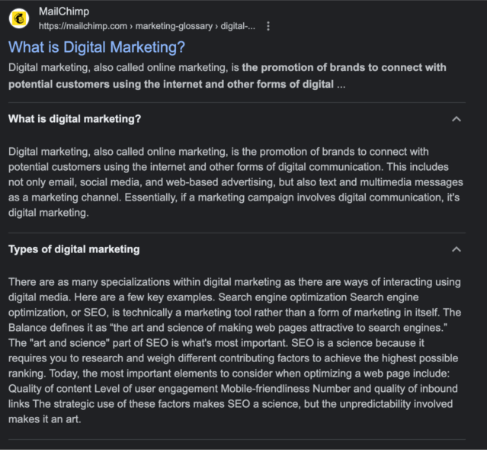
This is a good example from Mailchimp. We can see they have written an article on "What is digital marketing", and within that content they have answered the following questions:
- What is digital marketing?
- Types of digital marketing.
They have marked these questions with FAQ schema in order for Google to display this rich snippet, allowing us users to check the answers to these questions immediately, without clicking into the article at all.
How-To
You can use how-to schema (sometimes written as HowTo) to tell Google and other search engines that your content is a piece giving users information on exactly how to do something. You can feature text, images and video all within this.
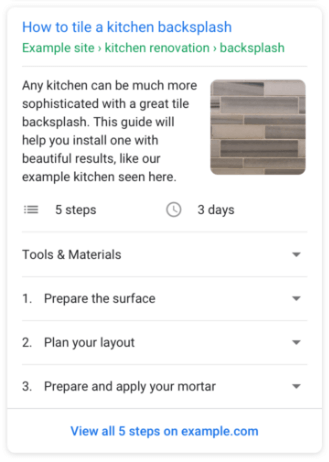
The above image shows a rich snippet which appears on the "How to tile a kitchen backsplash" search engine results page. You can see that it shows an intro to the article, the total number of steps, the time it will take to complete, and different sections and steps. This will give users a great intro to the article and give them the information they need right off the bat.
Local Business
Local business schema is basic information about the business, such as:
- The business name.
- The opening hours of the business.
- A telephone number for the business.
- Ratings from Google reviews.
- Links to websites.
Which will help a business display in the Google Knowledge Panel. Here's an example:
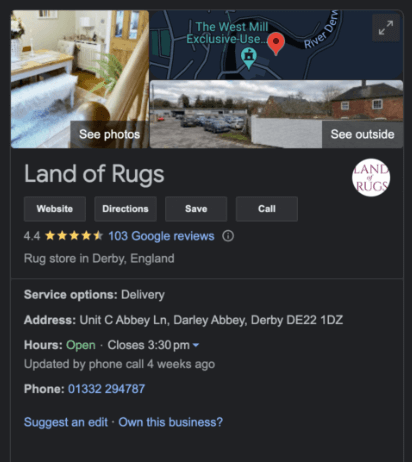
Adding in local business schema is a great way to give users the information they need about your business at a glance. The knowledge panel can show when users search for a brand name or a type of business (for example, rug sellers in Derby) so it is always best to add this in, no matter what your business does.
Logo
Using logo structured data, you can give Google and other search engines access to your logo so they can show it across search results. Ensuring you have logo schema implemented across your site will allow Google, for example, to show your business' logo within knowledge panels and across search result pages too.
Product
Adding product schema to your product pages will allow Google (and Google Lens, if applicable) to show different, more complex information about your product at a glance. Including:
- Price
- Availability
- Ratings
- Shipping Information
Google has two different result types that take advantage of product schema. Product snippets directly within search results and merchant listing experiences.
Product snippets show greater information about a product directly in the search result, rather than just plain old text. They can include additional information like ratings, price and availability.
Here's an example of a product snippet:

Here we can see the search listing shows the product's average rating, the number of reviews, the price and its current stock availability. All of this will give users an additional incentive to click on your search result over a competitor's listing.
Merchant listing experiences rely on more specific data about a product, including price and availability. Google will only allow pages where people can purchase a product to be eligible for merchant listing experiences.
Merchant listing experiences include:
- Popular products.
- Shopping knowledge panels.
- Google Images.
Q&A (Questions and Answers)
Webmasters and marketers can use Q&A schema to denote when content on their website lists both questions and the answers to those questions within its content. Whilst it can be used for an article answering one question and one question only, it is more commonly used when answering multiple questions on a similar topic.
Here's an example of a Google rich result in which Q&A schema has been used:

Review
Review schema is a commonly used markup type that allows you to mark reviews on your website for them to be displayed in different rich snippets. Google, in particular, may show a rich snippet that includes stars and other summary information from reviews or ratings.
Here's an example of a rich snippet that uses review schema:

As you can see, this particular listing within the search engine results page shows the aggregate rating for the homemade cake and the total number of reviews it has received. At a glance, this should give users enough information to decide whether they want to give the recipe a go, or not.
Overall, The Google Search Console 'Enhancements' tab is a great way to monitor your structured data, see where you are doing well, and see where you can improve and fix your structured data issues.
If you want to make even more of your Google Search Console data, consider signing up for SEOTesting. We have a free, 14-day free trial with no credit card requirement.

